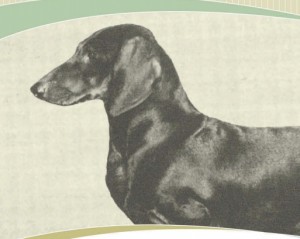The Dachshund
226 – May, 2016
by Amy Fernandez
 Dachshunds were an instant hit from the moment they stepped into a show ring back in 1860. You could also say that’s where the trouble started.
Dachshunds were an instant hit from the moment they stepped into a show ring back in 1860. You could also say that’s where the trouble started.
This hardbitten provincial breed had arrived in England about 20 years earlier, sent as gifts to the Royal Family from their German cousins. Prince Albert used them to hunt woodcock and pheasant in Windsor Forest. It was love at first sight for his wife, Queen Victoria, and her preference for the standard Smooths set the trend. Even though they represented one part of a wildly complex breed, Smooths dominated the scene for many decades thereafter.
Nothing says Germany like a Dachshund, but evidence suggests that innumerable strains and types existed all over northern Europe by the 1700s. Known by many regional names, the Dachshund’s freerange heritage encompassed numerous colors, coats, sizes and structural features. That crucial point got lost in the shuffle as every Dachshund convert in Britain scrambled to get their hands one of those fancy, imported German Badger Hounds. Needless to say, since the Queen preferred Standard Smooths, they became the exclusive focus of the ensuing demand.
Actually, a few things were overlooked during this festive era of Dachshund history. They were first exhibited in the Foreign Sporting Dog class at the seventh annual Birmingham show, Dec. 3-6, 1866. Separate Dachshund classes were first offered at the Crystal Palace Show, June 17-20, 1873, which was also the first show held under the auspices of the newly formed Kennel Club.
Dachshunds were among the first breeds documented by the Kennel Club. Unexplainably, the name German Badger Hound stuck with it for quite a while after that. James Watson wasn’t the only historian to suggest that a translation error sent the breed offtrack from the start of its career as a documented purebred. He wrote, “The meaning of the word ‘hund’ not being so well known as it should have been in England, led to the breed being given a class in the studbook under the title of ‘Dachshunds’ (or German Badger Hounds), in place of ‘badger dogs’, and this led to their being considered hounds and bred for hound heads, in place of the correct terrier type.”
Decades earlier, Rawdon Lee led the first wave of British Dachshund experts. He laid it out in his 1897 book Modern Dogs. He wrote, “He certainly appeared to be two animals rolled into one–a hound and a terrier–perhaps he is the connecting link between the two.” Lee’s speculation about the Dachshund as some kind of canine missing link indicates the pervasive confusion and misunderstanding about type within the British Dachshund fancy. Edward Ash summed it up with a typically witty observation. “Not many judges had the courage to grapple with this little hound when he did make an attempt to emerge from obscurity.” None of these critical issues impeded the breed’s momentum. It swiftly ascended to the height of purebred popularity.
Click here to read the complete article226 – May, 2016

Short URL: http://caninechronicle.com/?p=103598
Comments are closed











